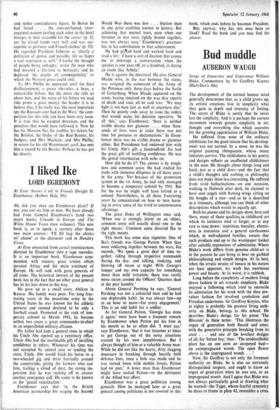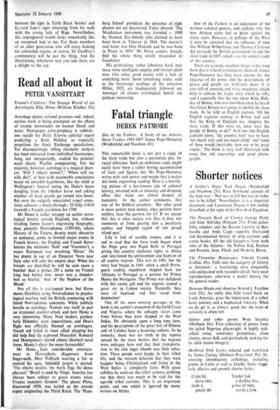Songs of Innocence and Experience William Blake. Commentary by Sir
Geoffrey Keynes (Hart-Davis 84s)
Bud muddle
AUBERON WAUGH The development of the normal human mind generally determines that, as a child grows up, its artistic creations lose in simplicity what they gain in " depth and intensity of feeling. The secret of Blake is surely that he never lost the simplicity. And it is perhaps the current movement towards greater simplicity in art, thought and everything else which accounts for the growing appreciation of William Blake.
He suffered from none of the ordinary' inhibitions for the good reason that his develop- ment was not normal. In a sense, he was the original painting chimpanzee, whose many imitators survive. The childishness in his poetry and designs reflects an unaffected childishness in the man. He thought about things long and hard, just as a child does—and the fact that a child's thoughts add nothing to philosophy does not make them less interesting. He suffered from vivid hallucinations—on one occasion, walking in Dulwich after dark, he claimed to have seen angels with flaming wings sitting on the boughs of a tree—and so he is described as a visionary, although one can think of other descriptions which would be equally apt.
Both his poems and his designs show, here and there, many of those qualitie% in childhood art which its imitators tend to forget, or at any rate to tone down : repetition, banality, clumsi- ness in execution and a general carelessness which, in well-adjusted families, ensure that such products end up in the wastepaper basket after suitable expressions of admiration. Where Blake's work differs from genuine child-art is in the passion he can bring to bear on garbled philosophising and simple designs. At its best, when the erratic strains of lunacy in his nature are least apparent, his work has enormous power and beauty. At its worst, it is rubbish.
Long before the complexity of modern living drove fashion in art towards simplicity, Blake enjoyed a following which tried to reconcile its admiration for his work with the then pre- valent fashion for involved symbolism and Freudian undertones. Sir Geoffrey Keynes, who at eighty is probably the greatest living auth- ority on Blake, belongs to this school. He describes Blake's design for his poem The Blossom' in these terms: 'This illustrates. the organ of generation both flaccid and erect, with the generative principle breaking from its crest . . .' and one of the loveliest designs of all, for 'Infant Joy,' thus: The unidentifiable plant has on one stem an unopened bud— an unimpregnated womb. The open flower above is the impregnated womb. .
Now, Sir Geoffrey is not only the foremost authority on Blake, he is also an extremely distinguished surgeon, and ought to know an organ of generation when he sees one, or an impregnated womb. And I agree that Blake was not always particularly good at drawing what he wanted—the Tyger, whose fearful symmetry he dares to frame in plate 42, resembles a cross between the tiger in 'Little Black Sambo' and EZ yard Lear's tiger returning from his walk with the young lady of Riga. Nevertheless, this impregnated womb looks remarkably like an unopened bud to me. For those members of an .older generation who still enjoy looking for concealed organs, of course, Sir Geoffrey's commentary will be just the thing. And the illustrations, whichever way you take them, are a delight to the eye.































 Previous page
Previous page